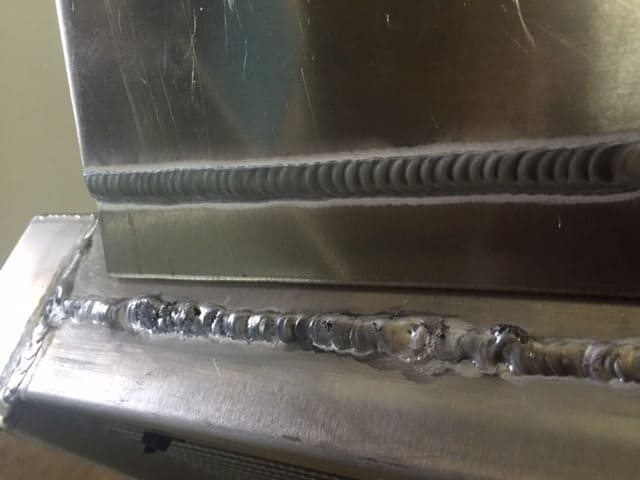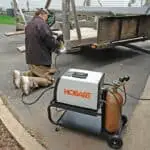Welding is used in so many aspects of our daily lives. Many of the things we rely on are made of metal, from our houses and office buildings to ships and vehicles.
It is required to manufacture practically everything made of metal, making it one of the most critical building processes.
Welding quality is of course critical, thus extensive and severe quality management is essential. But there is no generally strongest weld type that can be used in all welding operations. That is because the strength of the weld is determined by the base metal utilised and the size of the predicted pressure on the welded joint.
First let us deal with, how do we identify a strong weld from that of a weak weld?
Different welding procedures result in a diverse range of welds. And because welds vary so much, there are no hard and fast rules for distinguishing between good and bad welds.
Instead, we’ll have to examine each form of welding separately, and regardless of the procedure used to generate it, there are two primary elements we look for when determining a good weld vs bad weld, that is-
-
-
- Quality
- Strength
-
These two are intertwined in the sense that a low-quality weld is also low-strength.
So let’s look at different welding methods-
1.) Stick welding
Stick welding is one of the most simple techniques of welding to grasp. It’s adaptable to operate with various metals like alloy steel, carbon steel, stainless steel, iron, nickel, copper, and even aluminum.
Also known as Shielded Metal Arc Welding (SMAW), Flux Shielded Arc Welding, and Manual Metal Arc Welding (MMA).
An electric arc with alternating or direct electric current is used between the electrode and the metals to be bonded in the process.
The workpiece and electrode melt together to produce a weld pool, which cools to form a connection.
| Signs of good stick weld | Signs of bad stick weld |
| Straight and consistent.
There is no splatter. There are no holes, breakage, or cracks in the bead. |
Spatter
Undercutting Obvious absence of fusion, and cracking |
2.) MIG welding
It is the most popular form of welding and is typically thought to be the simplest. MIG, also known as Metal Inert Gas, is a procedure in which an electric arc is formed between a consumable wire electrode and the metals of the workpiece.
The ensuing heat melts and joins the metals. It’s used on a variety of thin metals, including stainless steel, mild steel, and aluminum.
| Signs of good MIG weld | Signs of bad MIG weld |
| Straight and consistent.
Smooth surface with no pattern. There is no slag, fracture, or hole. There are no dents or dips in the bead. |
Inconsistency.
Cracks through the centre of the bead, excessively thin. Lack of discoloration of the parent metal (which should be around 1/8 of an inch). |
3.) Oxy welding
Also known as gas welding, this technique is mostly used for maintenance and metal cutting, but it is also used to weld delicate aluminium components and braze soft metals such as bronze and copper.
It involves combining oxygen and acetylene gas to produce a flame capable of melting steel.
| Signs of good Oxy weld | Signs of bad Oxy welds |
| There are no holes or traces of molten metal.
Beads are consistent. |
Insufficient penetration
Excessive metal globs Oversized or undersized welds Undercut Overlap Incomplete fusion Porosity and cracking |
4.) TIG welding
Also known as Tungsten Inert Gas welding, it is a more difficult method of welding than stick or MIG welding and takes far more ability to produce great welds.
This sort of welding is utilised on a variety of metals, including aluminum, stainless steel, copper alloys, and magnesium, and can even be employed on two distinct metals at the same time.
It is used for high-quality work where a high grade of finish is required without the use of unnecessary clean-up by sanding or grinding.
| Signs of good TIG welds | Signs of bad TIG welds |
| Tiny welds that are precisely and stacked cleanly.
Aesthetically pleasing, and patterned. There is no slag residue or burnout. |
Burnout
Lack of filler metal Large flat bead with no discernible bead pattern Irregular beads Tungsten inclusion Porosity Undercutting |
But if you ask for the strongest out of the above, then this is what we recommend.
The strongest weld that can be formed in normal applications is one made using the Tungsten Inert Gas (TIG) welding process, often known as GTAW welding.
TIG welding generates a very strong weld because it totally melts the metal and creates a very strong bond. It is one of the strongest welding kinds because it totally melts the metal and prevents it from deforming or shrinking, making the joint as robust as possible.
It creates a crisp, clean, wonderfully constructed weld when it comes to details. It works well on a broad range of thinner-gauge materials, such as aluminum and stainless steel alloys, and is the method of choice for fine-tuned smaller jobs like gunsmithing, tool boxes, repairs, and aesthetic items.
Because of its capacity to make strong, quality welds on thin materials, TIG welding is employed in high-tech, high-impact sectors such as automotive and aerospace.
Because the filler metal is controlled manually by the operator, the beads may be significantly smaller and cause less disturbance in the surrounding metal.
Welding joints
Now talking about welding joints, they are an important aspect of any welding project. Because if you employ the wrong type of joint on the wrong project, it might compromise the entire structure.
There are various types of welding joints. It might be difficult to determine which weld is the strongest at times. So, we’re here to show you how to identify them and learn more about the joints.
1.) Tee joint
As the name suggests, this type of joint has two objects or pipes meeting at a perpendicular 90-degree angle, and as a result, it creates a ‘T’ shape.
Once the pipes or tubes are in place, heat and pressure are used to secure them.
When constructing such a connection, extreme caution must be exercised to ensure the most effective penetration. When the items are perpendicularly arranged, this sort of joint is employed. It is commonly used to connect plates or branches.
See also: Pipe Welding Positions Chart
2.) Butt joint
This is one of the most common joints and is the most often used. And this is something you’ll use if you need to connect two additional pipes. The pipe mouths are positioned together, allowing the metals to merge and form one.
Along with pipes, this is widely used for fittings, valves, and a variety of other types of equipment. The pieces are rowed in a line and then moulded together using heat. Because there is no curvature or difficulty in the procedure, this is one of the simplest joints to make.
3.) Lap joint
It occurs when two pieces are linked while one overlaps the other. For this system to function, the tubes or pipes might be of varying lengths or even thicknesses.
This is classified as a fillet joint, similar to the tee joint. And in this case, you may combine two or more things.
4.) Edge joint
This one is a little different from the others and can be a little more difficult. These are most typically used for metal sheets with flanging borders. Edge joint is also beneficial when the metal sheet has to be joined to another.
The components must be placed next to one another for this joint, and the edges will be fused together using heat. Other materials may be required to construct a joint in some cases. The other metals melt and aid in their bonding.
5.) Corner joint
Just as the butt joint is used for pipes, this one is more typically used to link the outer edge of metal sheets. When the two parts are brought together, a straight angle should occur, or a ‘L’ shape should develop.
Weld was utilised to fill in the corner. It can also provide stronger welding. When boxes are constructed, you’ll generally see joints like this.
Strongest welding joint according to us
There are one or two types of joints that are considered stronger than others. However, this is dependent on various factors, like your ability and your experience with welding along with the materials being used.
Most of these joints are fairly sturdy if you use proper methods and techniques. However, most welders will tell you that applying a groove to gain sufficient penetration with an arc welder on a corner or tee joint will result in the strongest weld.
Conclusion
Welding is one of the most important building operations in today’s world. It’s a vital ability for any professional or novice welder since it allows you to make almost anything out of metal.
Of course, there’s a lot to learn, such as the variations between different welding procedures and welding different metals and joints. But, at least, you’ll know which welding methods give you the type of strength you require for your welding.







